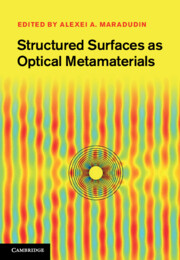Book contents
- Frontmatter
- Contents
- List of contributors
- Preface
- 1 Physics of extraordinary transmission through subwavelength hole arrays
- 2 Resonant optical properties of nanoporous metal surfaces
- 3 Optical wave interaction with two-dimensional arrays of plasmonic nanoparticles
- 4 Chirality and anisotropy of planar metamaterials
- 5 Novel optical devices using negative refraction of light by periodically corrugated surfaces
- 6 Transformation of optical fields by structured surfaces
- 7 Surface electromagnetic waves on structured perfectly conducting surfaces
- 8 Negative refraction using plasmonic structures that are atomically flat
- 9 Anomalous transmission in waveguides with correlated disorder in surface profiles
- 10 Cloaking
- 11 Linear and nonlinear phenomena with resonating surface polariton waves and their applications
- Index
- Plate section
- References
9 - Anomalous transmission in waveguides with correlated disorder in surface profiles
Published online by Cambridge University Press: 01 June 2011
- Frontmatter
- Contents
- List of contributors
- Preface
- 1 Physics of extraordinary transmission through subwavelength hole arrays
- 2 Resonant optical properties of nanoporous metal surfaces
- 3 Optical wave interaction with two-dimensional arrays of plasmonic nanoparticles
- 4 Chirality and anisotropy of planar metamaterials
- 5 Novel optical devices using negative refraction of light by periodically corrugated surfaces
- 6 Transformation of optical fields by structured surfaces
- 7 Surface electromagnetic waves on structured perfectly conducting surfaces
- 8 Negative refraction using plasmonic structures that are atomically flat
- 9 Anomalous transmission in waveguides with correlated disorder in surface profiles
- 10 Cloaking
- 11 Linear and nonlinear phenomena with resonating surface polariton waves and their applications
- Index
- Plate section
- References
Summary
Introduction
In recent years, increasing attention has been paid to the so-called correlated disorder in low-dimensional disordered systems. Interest in this subject is mainly due to two reasons. First, it was found that specific correlations in a disordered potential can result in quite unexpected anomalous properties of scattering. Second, it was shown that such correlations can be relatively easily constructed experimentally, at least in the one-dimensional Anderson model and in Kronig–Penney models of various types. Therefore, it seems to be feasible to fabricate random structures with desired scattering properties, in particular when one needs to suppress or enhance the localization in given frequency windows for scattering electrons or electromagnetic waves. In addition, it was understood that, in many real systems, correlated disorder is an intrinsic property of the underlying structures. One of the most important examples is a DNA chain, for which strong correlations in the potential have been shown to manifest themselves in an anomalous conductance. Thus, the subject of correlated disorder is important both from the theoretical viewpoint, and for various applications in physics.
The key point of the theory of correlated disorder is that the localization length for eigenstates in one-dimensional models absorbs the main effect of correlations in disordered potentials. This fact has been known since the earliest analytical studies of transport in continuous random potentials. However, until recently the main interest was in delta-correlated potentials, or in potentials with a Gaussian-type of correlation.
- Type
- Chapter
- Information
- Structured Surfaces as Optical Metamaterials , pp. 287 - 315Publisher: Cambridge University PressPrint publication year: 2011

